Chapter 19 Berkley Square
 fter the death of Alice (nee Ridley) the fortunes of the family of John(1703.42) divided. The Tetsall family in London Atook a keen interest in their grandchildren, not that I suppose they neglected the children of John and Alice, but the fortunes of the Tetsalls followed their first grandson Stephen(1743.46) son of John and Mary.
fter the death of Alice (nee Ridley) the fortunes of the family of John(1703.42) divided. The Tetsall family in London Atook a keen interest in their grandchildren, not that I suppose they neglected the children of John and Alice, but the fortunes of the Tetsalls followed their first grandson Stephen(1743.46) son of John and Mary.
By the time Stephen was thirty-five, he had bought a wine dealers business in Conduit Street, London.272 The large frontage shop adjoined the entrance to rather grand block apartments curving round the corner. Situated less than half a mile from Hyde Park and a few hundred metres from Berkley square and Hanover Square, this was the residence of the painter John Copley273, (who still lived and worked above the shop when Stephen bought it)274. Later, it was turned into the famous, (perhaps infamous), Limmer Hotel275. How did Stephen(1743.46) came to these surroundings? James Tetsall kept the Hertford Arms, public house, at 68 Grosvenor Street,276 one block away from Conduit Street and Hanover Square. Margaret, William, and Thomas Tetsall also lived within a few blocks of the Square. John(1703.42) and Mary would have brought the children to visit mother’s relations in London.
During this period277 of history, visits to relations in London were important for up and coming of the more affluent sections of society, not only for the socialising but also matchmaking teenage grandchildren. Stephen’s attraction to Elizabeth Deares no doubt began here. The Deares family who lived local to the Tetsals, had connections with the military and may have helped Stephen(1743.46) and friend William Ladbrook,278 (a breeches maker from New Bond street), to gain several contracts with one – Mr. Montagu Henry. The contract was to supply the British Navy with breeches, rum and beer between 1800 and 1815.279
The list of Stephen’s neighbours is also impressive. Among these are the Duke of Roxburgh, The Earl of Harewood, Sir Francis Dashwood and Lord Le Despencer. Stephen(1743.46) received a portion of estates of Sir George Strickland, (another Military man), on the 30th March 1810280 This then, was the society Stephen's
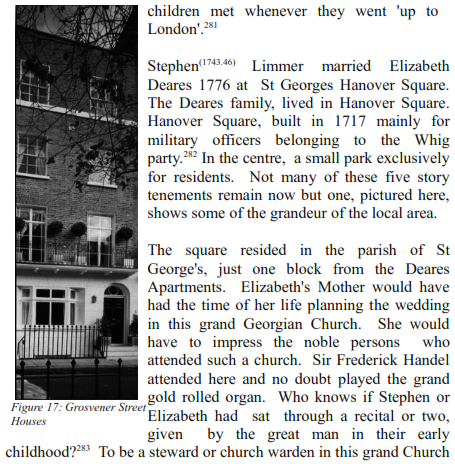
you would need to be titled by the realm. St George’s, attended by many of London’s ‘ Elite’, has an impressive list of deacons and officers. If I judge Stephen’s character correctly, this would have intimidated him; I think he would feel quiet uncomfortable in such an elite congregation.
Quite why this family drove by284 four churches to go to a church in Marylebone for the baptism of their children remains a question. Those wishing to be named among society would have not done so. Society would have revolved around St James or Westminster in the opposite direction and, of course, St George’s Hanover Square.
St. Mary’s was a small, rather plain church serving a parish of 5000 people when Stephen joined it. By 1800 AD the population of the parish was heading for sixty-four-thousand. Stephen may well have been on the Parochial Church Council when it decided to build a new church. However, with the frustration in finding a new site, the church eventually extended the existing church building, continuing its work among the poor of the parish with a mission hall on the other end of the large parish.
Stephen and Elizabeth seem to became active in the church of St.
Mary Le-bone which was quiet different in nature to St. George’s.
The contrast with St George’s and St Mary’s can be seen from the writings of Charles Dickens who was associated with St Mary's. His descriptions of Victorian society surely came from the contrast of these two parishes so close together and yet so diverse in Character. Soon after Stephen's death, 'the Crown' developed Regents Park where a Grand new church was built as the Parish church leaving the old church as a mission to continue -and thus effectively distancing its upper society from a work amongst the poor of the parish.
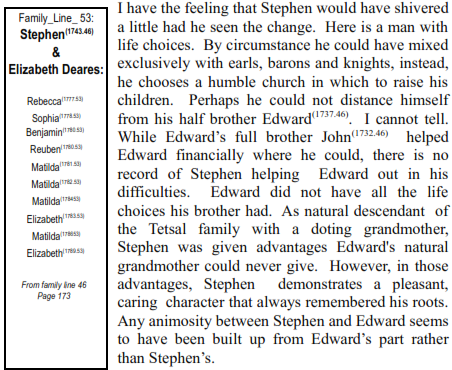
Stephen(1743.46) owned and kept the ‘ house in the country’, (Tuddenham). Until his parents died, Stephen spent most of his time in London with his family, Elizabeth died in London but was buried 9th May 1807 at Tuddenham. On the death of Elizabeth in 1807 Stephen returned to Tuddenham as his main residence and spent little time in London. He also was buried in Tuddenham. Stephen(1743.46) died ten years later on 11th June 1817 being buried 19th June 1817.
The children of Stephen(1743.46) 285 and Elizabeth Deares:
1) Rebecca baptised 23rd March 1777 Marylebone St Mary.
2) Sophia, (who later married William Hassell) 286, was baptised 6th July 1778 Marylebone St Mary. Sophie’s husband William died pre 1817. (They had least one son - Charles Stephen Hassell).
3) Benjamin baptised 5th March 1780 Marylebone St Mary, and buried age five on 23rd January 1785 at Tuddenham.
4) Reuben baptised 5th March 1780 Marylebone-St-Mary.
Tragically four daughters born after Reuben died at birth
5) Matilda born July 1781 Marylebone died Aug 1781 Marylebone
6) Matilda born July 1782 Marylebone died July1782 Marylebone
7) Matilda born August 1784 Marylebone died August 1784 Marylebone
8) Elizabeth born 1783
9) Matilda born 1786 St Georges Hanover Sq died Oct 1859 London later married Roylance Child,
10) Elizabeth born 1789 London later married William Beattie,
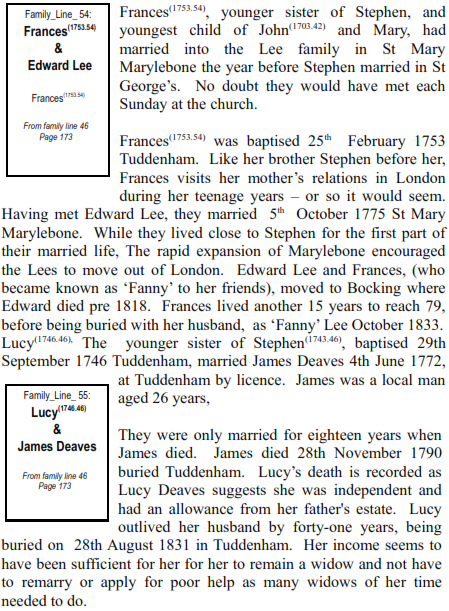
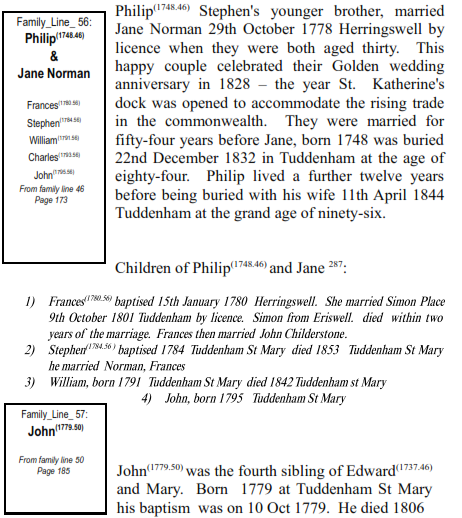
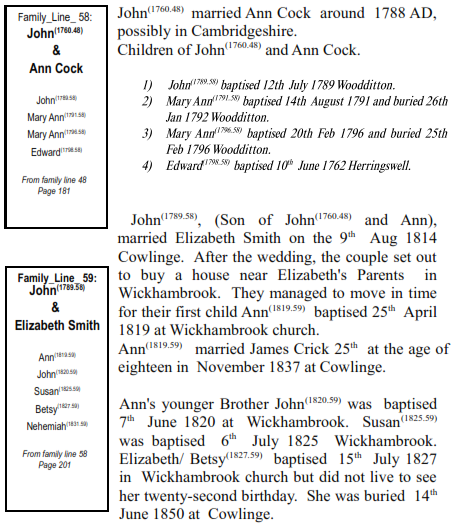
Elizabeth's parents - the Smith family, moved to Cowlinge, (some fifty miles away), John and Elizabeth followed them around 1810. Nehemiah(1831.59) baptised 30th June 1831 Wickhambrook, was also buried young on 1st Oct 1848 at Cowlinge, Aged 21. Finally, John(1789.58) died at Cowlinge 1860 age 71 and Elizabeth died at Cowlinge, being buried 12th Oct 1874.
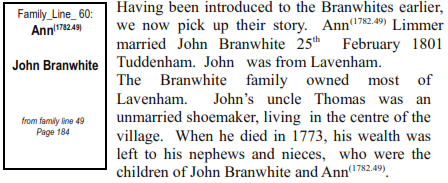
John’s sister Ann received a tenement in the market place with its yards gardens and outhouses, including the shoemaking concern, from which she was to pay Sarah (John’s second sister), thirty pounds annually.
Besides a second tenement in the market square, John inherited several other properties and sums of monies around two-hundred-and-fifty pounds.
John Branwhite also inherited, from his father on his death in 1777, a linen drapery business. His sisters, ‘having refused to take upon themselves’ any part in the running of the concern, were left sums of money from other sources.
It seems, from several sources, that the Branwhites were aspiring to the league of gentlemen. Uncle Thomas Branwhite, “a gentleman”, had a pig stolen and killed on his premises according to local assizes. Ann Branwhite (John’s sister), Married ‘ a gentleman from Lavenham’, (one of the well established Prentice family).
John seemed to have a mean streak in him when it came to possessions. he has no problem in bringing a court case on John Clark for stealing 13 handkerchiefs.

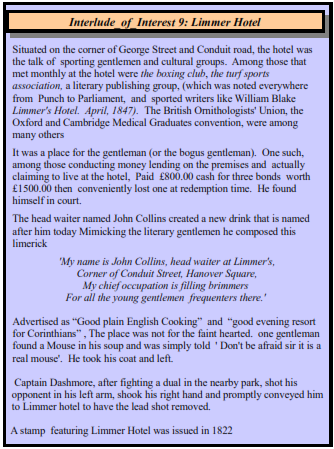





 fter the death of Alice (nee Ridley) the fortunes of the family of John
fter the death of Alice (nee Ridley) the fortunes of the family of John







